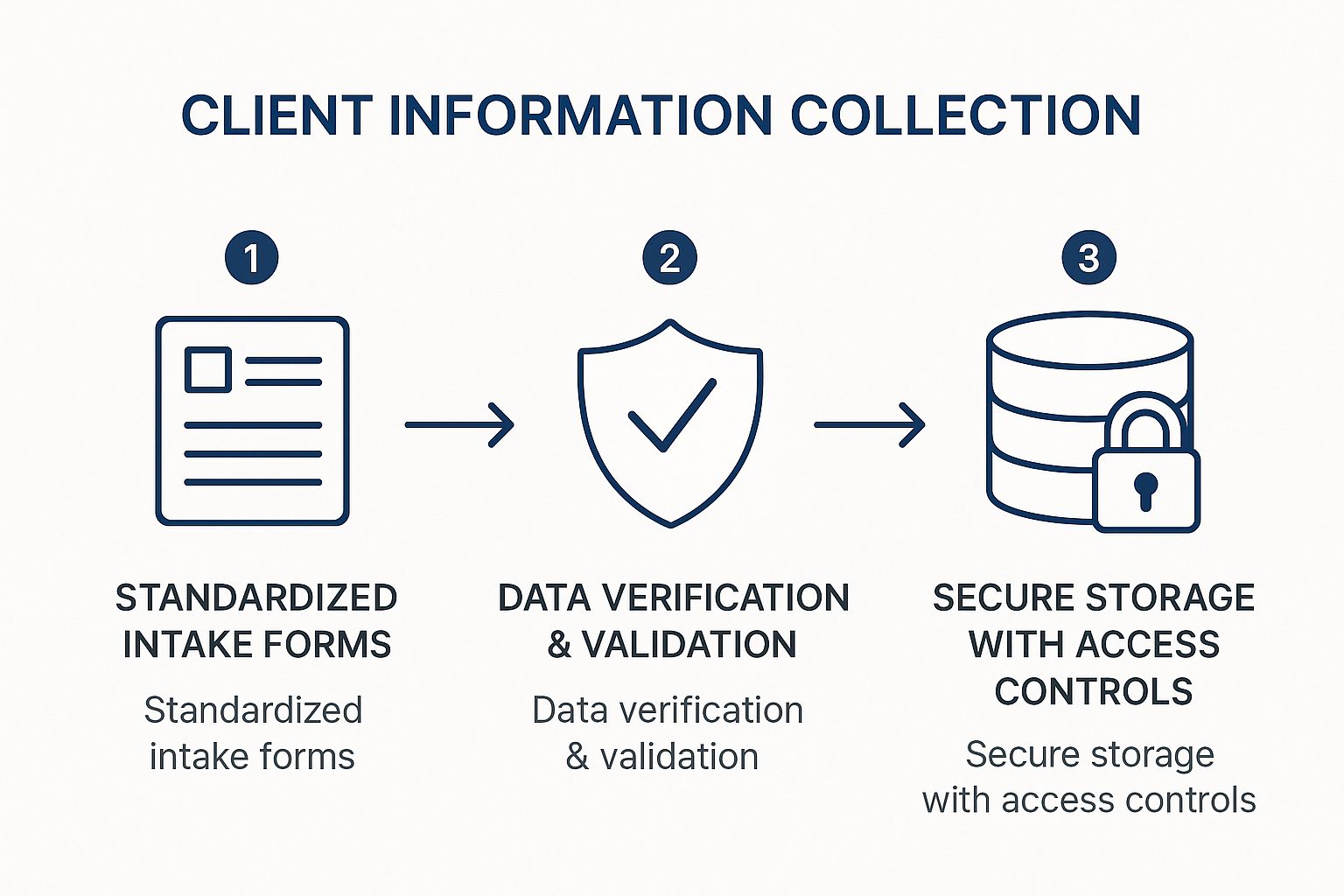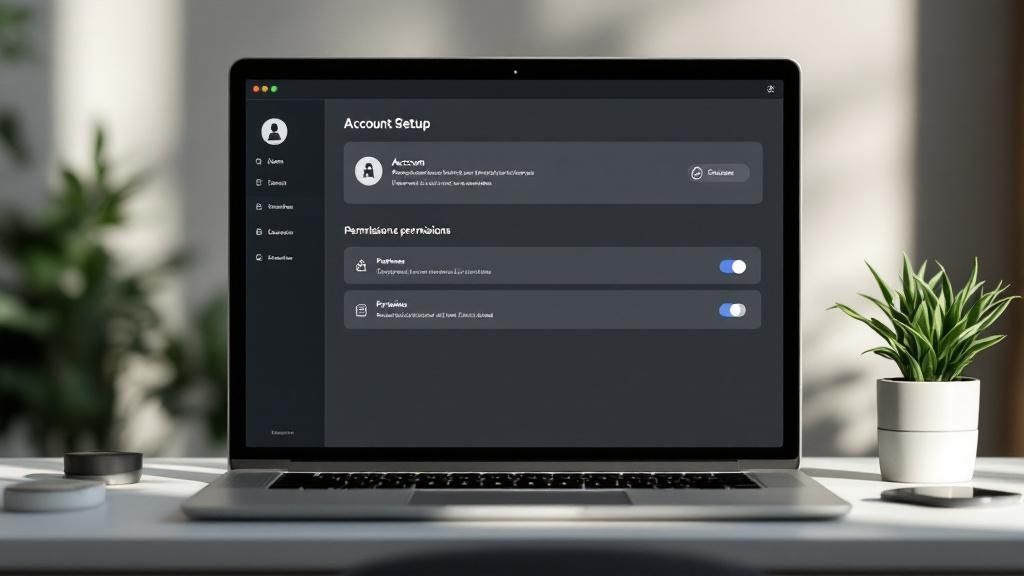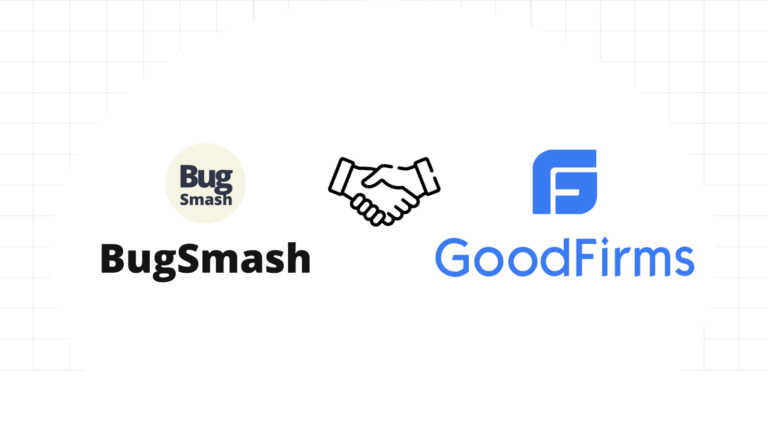The moment a client signs the contract isn't the finish line; it's the starting block of a long-term partnership. A clunky, disorganized, or confusing start can erode trust before you’ve even begun, leading to scope creep, endless email chains, and a frustrated client. Conversely, a seamless, structured onboarding experience sets the stage for success, builds confidence, and shows clients they've made the right choice. This isn't just about administrative tasks; it's your first opportunity to demonstrate value, professionalism, and the efficiency you promised.
This focus on a strong first impression is a universal principle. While this article focuses on external clients, many of the same ideas apply internally. For a deeper dive into structuring new relationships for success, you can explore some excellent developer onboarding best practices that share this core philosophy.
In this guide, we'll break down the ultimate 8-step client onboarding checklist to help you create a repeatable process that delights clients and sets every project up for a win. We'll cover everything from initial documentation and goal setting to planning for those crucial early victories. We'll also highlight how leveraging modern tools can transform this critical phase from a chore into a competitive advantage.
1. Foundation First: Client Information Collection and Documentation
A successful project is built on a solid foundation of shared understanding. The very first step in any effective client onboarding checklist is to systematically collect, verify, and document all essential client information. This moves beyond a simple name and email; it's about creating a centralized knowledge base that will serve as the single source of truth for the entire project lifecycle.
By establishing a standardized process, you eliminate the risks of miscommunication and guesswork that often derail projects before they even begin. When your team has immediate access to key business objectives, technical requirements, stakeholder contacts, and brand guidelines, they can make informed decisions quickly and confidently. This initial investment in thorough documentation pays dividends in efficiency, accuracy, and ultimately, client satisfaction.
The Information Collection Workflow
To ensure no detail is missed, implement a structured, multi-step approach to gathering data. This isn't a one-time data dump but a deliberate process to guarantee the information is accurate, secure, and accessible to the right people. A robust workflow prevents crucial details from slipping through the cracks.
- Standardized Intake: Use comprehensive digital forms or questionnaires to capture everything from high-level goals to granular details like login credentials or specific compliance needs.
- Verification: Schedule a kickoff call to review the submitted information, ask clarifying questions, and confirm everyone is aligned.
- Centralized Storage: Store all documents and data in a secure, shared repository like a project management tool or a dedicated cloud folder with clear access controls.
The following infographic illustrates this simple yet powerful workflow for client information collection.

This streamlined process ensures that from day one, your team is operating with verified, secure, and easily accessible information. Having a well-defined system like this is the bedrock of a personalized and efficient service. For a head start, you can explore our detailed guide and learn how to create a comprehensive project documentation template.
2. Welcome Package and Initial Communication Setup
The first impression can define the entire client relationship. A thoughtfully prepared welcome package and a clear communication setup are essential for starting the partnership on the right foot. This step in your client onboarding checklist goes beyond a simple greeting; it’s about making the client feel valued, informed, and confident in their decision to work with you.
By proactively providing key information, introducing your team, and establishing communication protocols from day one, you build immediate trust and set a positive tone. This curated experience demonstrates your professionalism and organizational prowess, assuring clients they are in capable hands. It minimizes early-stage anxiety and prevents the common "what's next?" confusion, paving the way for a smooth and collaborative project.

Crafting a Memorable Welcome Experience
A successful welcome strategy combines personalized touches with practical information. The goal is to make the client feel like a priority while equipping them with everything they need to engage with your team effectively. This structured approach ensures every new client receives the same high standard of introduction.
- Personalized Welcome Kit: Create a digital or physical package that includes a personalized welcome letter, introductions to key team members (with photos or video clips), and a clear project roadmap.
- Set Communication Rules: Clearly define primary points of contact, preferred communication channels (e.g., email, Slack, BugSmash for feedback), and expected response times.
- Provide Essential Resources: Grant access to all necessary tools, dashboards, and resource libraries. Include a client-facing checklist so they can track their own onboarding tasks.
This initial setup is crucial for establishing a healthy, transparent working dynamic. Building a strong foundation from the start is one of the most important client communication best practices you can adopt.
3. Contract and Legal Documentation Review
With a solid foundation of client information in place, the next crucial step in your client onboarding checklist is to formalize the partnership legally. This involves the systematic review, negotiation, and execution of all necessary contracts and legal documents. This isn't just a formality; it's about creating a clear, legally-binding framework that protects both your business and your client, defining the scope, responsibilities, and terms of engagement upfront.
By treating contract management as a core part of the onboarding experience, you mitigate legal risks and prevent future disputes over deliverables, timelines, and payment. A transparent and professional legal process instills confidence and sets a precedent for a relationship built on trust and mutual respect. This stage transforms a potential partnership into a well-defined, official engagement ready for success.
The Legal Framework Workflow
An efficient legal workflow ensures that all agreements are handled smoothly, without creating a bottleneck in the onboarding process. The goal is to be thorough yet swift, making the process as painless as possible for your new client while ensuring complete compliance. This structured approach prevents legal oversights that could have long-term consequences.
- Standardized Templates: Use attorney-approved templates for common agreements like Service Level Agreements (SLAs), Non-Disclosure Agreements (NDAs), and Data Processing Agreements (DPAs) to ensure consistency and compliance.
- Clear Communication: Provide clients with a simple summary or a walkthrough of key contract clauses, especially regarding scope, payment terms, and intellectual property. Once drafted, contracts should always be thoroughly reviewed. For expert assistance, consider the importance of having a contract laten controleren to ensure all terms are fair and understood.
- Streamlined Execution: Employ e-signature platforms like DocuSign or Adobe Sign to accelerate the signing process, creating a secure and verifiable audit trail for all executed documents.
This professional approach to legal documentation solidifies the client relationship and formally kicks off your collaboration on the right foot. It’s a non-negotiable step for any agency or business serious about long-term success and risk management.
4. Account Setup and Access Provisioning
With the foundational information secured, the next critical step in your client onboarding checklist is the technical setup. This involves provisioning access to all necessary tools, platforms, and systems your client will need to collaborate effectively. A smooth, error-free access handoff demonstrates technical competence and removes frustrating initial barriers, setting a positive tone for the entire relationship.
This stage is about more than just creating a username and password. It's about empowering the client with the right permissions and a clear understanding of the digital environment they'll be working in. A disorganized or delayed setup can cause immediate friction and project delays, while a streamlined process reinforces that you are organized, professional, and ready to get to work.

The Access Provisioning Workflow
To guarantee a seamless experience, you must systemize the creation and delivery of client access. This prevents security gaps and ensures clients can immediately engage with tools like project management software or feedback collection platforms. A methodical approach is non-negotiable for efficiency and security.
- Standardized Packages: Develop pre-defined access templates based on client type or project scope. For instance, a "Standard Client" package could grant access to Asana and a shared cloud folder, while a "Premium Partner" gets additional access to analytics dashboards.
- Guided Setup: Provide clients with simple, step-by-step guides complete with screenshots or short video tutorials. This documentation should walk them through logging in for the first time, setting up their profile, and navigating key features.
- Pre-Handoff Verification: Before sending credentials, have an internal team member test all access points. This simple quality check ensures everything works as expected, preventing the classic "my login doesn't work" email.
By implementing this workflow, you ensure every client feels empowered, not overwhelmed, from their very first interaction with your systems. To further streamline the feedback loop during this phase and beyond, consider how a tool like BugSmash can help clients easily report any access issues or system bugs directly from their screen.
5. Team Introductions and Role Assignments
Beyond contracts and questionnaires, the human element is what transforms a business transaction into a successful partnership. A crucial step in any client onboarding checklist is the strategic introduction of your team. This process is about more than just names and titles; it’s about establishing trust, clarifying communication pathways, and ensuring the client knows exactly who to turn to for specific needs.
By formally introducing the team and defining each person's role, you demystify the working relationship and build immediate confidence. Clients feel more secure when they can put a face to a name and understand the expertise behind the project. This clarity prevents confusion, streamlines communication, and sets the stage for a collaborative and productive engagement from day one.

The Role Clarity Framework
To foster strong working relationships, implement a clear framework for introductions and role definitions. This ensures clients feel connected and supported, rather than being handed off to a faceless department. A structured approach removes ambiguity and empowers both your team and the client.
- Curated Introductions: During the kickoff meeting, introduce the core team members who will be the client's main points of contact. Avoid overwhelming them with the entire organizational chart.
- Role Definition: Clearly articulate what each team member is responsible for. For example, "Sarah is your dedicated Project Manager for all scheduling and progress updates, while David is the lead developer for any technical inquiries."
- Communication Channels: Establish primary and secondary contacts for every key area, creating a clear escalation path. This prevents bottlenecks and ensures timely responses.
This methodical process ensures that clients never feel lost or unsure of who to contact. Having a transparent system like this is fundamental to building a strong foundation of trust. For more strategies on creating a cohesive project environment, you can explore our guide on boosting team collaboration.
6. Goal Setting and Success Metrics Definition
A project without clear goals is like a ship without a rudder. To steer your collaboration toward a successful outcome, you must collaboratively define what success looks like from the very beginning. This step involves establishing clear, measurable objectives and the key performance indicators (KPIs) that will track progress, ensuring both you and your client are aligned on the ultimate destination.
This process transforms abstract expectations into a concrete action plan. When everyone understands the specific targets, from short-term wins to long-term ambitions, the entire project gains focus and purpose. This is a cornerstone of a robust client onboarding checklist, as it provides a framework for decision-making, resource allocation, and transparent communication, preventing scope creep and keeping the engagement on track.
The Success Definition Workflow
Defining success isn't a one-sided declaration; it's a collaborative discovery process. By working with your client to set goals and metrics, you foster a sense of shared ownership and partnership. This structured approach ensures that the objectives are not only ambitious but also realistic and directly tied to business value.
- Define Primary Objectives: Start by identifying the top 3-5 high-level goals the client wants to achieve. This focus prevents overwhelm and clarifies priorities.
- Establish Measurable KPIs: For each objective, assign specific KPIs. For a marketing campaign, this could be conversion rate; for a SaaS implementation, it might be user adoption percentage.
- Set Review Cadence: Agree on a regular schedule (e.g., bi-weekly or monthly) to review progress against these KPIs, allowing for agile adjustments.
"What gets measured gets managed." This principle, often attributed to Peter Drucker, is the driving force behind this step. By quantifying success, you create a clear path to achieving it.
This collaborative goal-setting process ensures that every action taken is purposeful and contributes directly to the client's desired outcomes. It lays the groundwork for a transparent and results-driven partnership, which is essential for long-term client retention.
7. Training and Knowledge Transfer
A smooth partnership depends on empowering your client with the knowledge they need to succeed. The seventh step in a comprehensive client onboarding checklist is to deliver structured training and knowledge transfer. This is not about a single, overwhelming info-dump; it’s about creating an educational journey that equips clients with the skills and understanding to use your tools, follow processes, and collaborate effectively.
By investing in client education, you transform them from passive recipients into active, confident partners. When clients understand the 'why' behind your methods and the 'how' of your systems, they can provide higher-quality feedback, make faster decisions, and fully leverage the value you provide. This proactive approach minimizes confusion, reduces support requests, and builds a stronger, more collaborative relationship from the start.
The Client Education Workflow
To ensure training is effective and not just a formality, implement a tailored educational plan. This workflow moves beyond a generic presentation to deliver relevant, accessible, and continuous learning opportunities that respect your client's time and skill level. A well-designed training plan is the key to long-term adoption and success.
- Tailored Content Creation: Develop training materials based on the client’s specific role, goals, and technical proficiency. Use a mix of formats like live demos, video tutorials, and written guides.
- Structured Delivery: Schedule initial training sessions during onboarding and supplement them with on-demand resources. Platforms like Salesforce's Trailhead and HubSpot's Academy have popularized this model of combining guided learning with self-service resources.
- Ongoing Reinforcement: Create quick reference guides for common tasks and schedule brief follow-up sessions to answer questions and reinforce key concepts, ensuring knowledge retention.
This structured educational approach guarantees your clients are not just onboarded but are truly enabled. By providing clear, accessible training, you set the stage for a partnership where both teams operate with confidence and clarity. To enhance your training with practical, hands-on feedback collection, consider how a tool like BugSmash can be integrated into your user acceptance testing and educational sessions.
8. First Milestone Planning and Quick Wins
Momentum is a powerful force in any new client relationship. To harness it, your client onboarding checklist must prioritize the strategic identification and delivery of early, achievable objectives. This "quick win" approach demonstrates immediate value, builds client confidence, and creates positive momentum that propels the entire project forward.
By focusing on tangible results within the first 30 to 90 days, you move the partnership from abstract plans to concrete achievements. This proves your team's capability and reassures the client that their investment is already paying off. This proactive strategy is crucial for setting a collaborative tone and building a foundation of trust that will be essential when tackling more complex, long-term goals.
The Quick Win Implementation Cycle
Executing a successful quick win requires more than just picking the lowest-hanging fruit; it demands a strategic cycle of identification, execution, and communication. This ensures the initial victory is not only swift but also meaningful and aligned with the client's ultimate objectives. A well-managed cycle turns a small task into a significant milestone.
- Strategic Identification: Analyze the client's primary pain points and long-term goals to identify a high-impact, low-effort objective. For example, a digital agency might perform a quick technical SEO audit and fix critical errors before starting a full website redesign.
- Focused Execution: Create a detailed micro-plan for this specific milestone, assign clear responsibilities, and execute with precision. This could involve a consulting firm implementing a single, immediate process improvement while mapping a larger transformation.
- Visible Communication: Document the process and results clearly. Celebrate the achievement with the client, explicitly connecting this initial success to the broader project roadmap and building excitement for what's next.
This cycle validates your expertise and reinforces the client's decision to hire you. For an effective way to track progress on these initial tasks and gather feedback, consider using a tool like BugSmash. Its visual feedback capabilities make it easy for clients to see and approve the work you're doing, ensuring everyone is aligned. Explore how you can streamline this with a tool designed for clear communication and rapid feedback cycles on the BugSmash website.
Client Onboarding Checklist Comparison
| Item | Implementation Complexity 🔄 | Resource Requirements ⚡ | Expected Outcomes 📊 | Ideal Use Cases 💡 | Key Advantages ⭐ |
|---|---|---|---|---|---|
| Client Information Collection and Documentation | Medium – involves forms, validation, secure storage | Moderate – digital tools, CRM integration | Accurate client data, compliance, personalized service | Initial onboarding, compliance-heavy projects | Reduces errors, legal protection, data consistency |
| Welcome Package and Initial Communication Setup | Low – content creation and delivery | Low to Moderate – branded materials, communications | Positive impression, trust, clear expectations | New client introductions, brand building | Builds trust, sets expectations early |
| Contract and Legal Documentation Review | High – legal expertise and review workflows | Moderate to High – legal resources and review time | Legal protection, clear terms, compliance | Any legally sensitive client relationships | Protects both parties, defines scope clearly |
| Account Setup and Access Provisioning | Medium to High – technical setup and permissions | Moderate – IT coordination and software tools | Immediate access, secure environment | Software onboarding, IT environments | Ensures security, reduces support issues |
| Team Introductions and Role Assignments | Low to Medium – coordination across teams | Low – communication tools and scheduling | Clear accountability, trust, efficient communication | New projects requiring defined contacts | Builds connections, clarifies roles |
| Goal Setting and Success Metrics Definition | Medium – framework setup and monitoring | Moderate – dashboard tools, regular reviews | Clear focus, measurable success, transparency | Performance-driven engagements, long-term projects | Enables data-driven decisions, client alignment |
| Training and Knowledge Transfer | Medium to High – content development, delivery | High – time, materials, multiple formats | Client empowerment, reduced support needs | Complex tools/processes, long-term collaboration | Improves self-sufficiency, demonstrates expertise |
| First Milestone Planning and Quick Wins | Medium – planning and resource allocation | Moderate – project management resources | Early value delivery, momentum building | New projects seeking early ROI and engagement | Builds confidence, quick value demonstration |
From Checklist to Competitive Advantage
An exceptional client onboarding process is more than a series of administrative tasks; it’s the foundational system for building trust, ensuring clarity, and launching a successful, long-term partnership. By moving beyond a simple to-do list and embracing a structured, tool-assisted approach, you transform onboarding from a procedural hurdle into a powerful competitive differentiator. The eight steps we've detailed provide a robust framework, but the real magic happens when you master the execution.
Think of your client onboarding checklist not just as a sequence of events but as a series of strategic touchpoints. Each stage, from initial information collection to planning the first quick win, is an opportunity to reinforce your value, demonstrate your expertise, and align your team with the client's vision. A disjointed or confusing start can sow seeds of doubt that are difficult to overcome later. Conversely, a smooth, transparent, and professional onboarding experience immediately validates the client's decision to choose you.
Turning Process into Partnership
The most significant takeaway is that a great onboarding experience is a shared one. It requires seamless collaboration, clear communication, and a single source of truth. The challenges often lie in the gaps between these steps: mismanaged expectations during goal setting, lost feedback during training, or communication breakdowns when assigning roles. This is where dedicated tools become indispensable.
By integrating a platform like BugSmash to manage feedback and approvals, you directly address these potential friction points. Instead of relying on scattered email threads or confusing spreadsheets, you create a centralized hub where communication is visual, contextual, and actionable. This elevates the client experience from merely adequate to truly exceptional.
Key Insight: Mastering your client onboarding checklist is about more than just efficiency. It’s about creating a repeatable system that builds client confidence and sets the stage for mutual success from day one.
Your Actionable Next Steps
To put this into practice, don't try to overhaul everything at once. Start by auditing your current process against the eight stages outlined in this article. Identify the single biggest bottleneck or point of client friction. Is it the handoff between sales and project management? Is it the technical setup and access provisioning?
Focus your initial efforts there. Implement one or two improvements, such as creating a standardized welcome package or using a tool to streamline the feedback process on initial deliverables. By making incremental, high-impact changes, you can begin to see immediate improvements in client satisfaction and internal efficiency. This iterative approach allows you to build a world-class client onboarding checklist that becomes a cornerstone of your business operations and a true competitive advantage.
Ready to eliminate the confusion and endless email chains from your client onboarding process? BugSmash provides a visual feedback and bug reporting tool that makes collaboration effortless. See how you can streamline approvals and deliver a superior client experience by trying BugSmash today.




